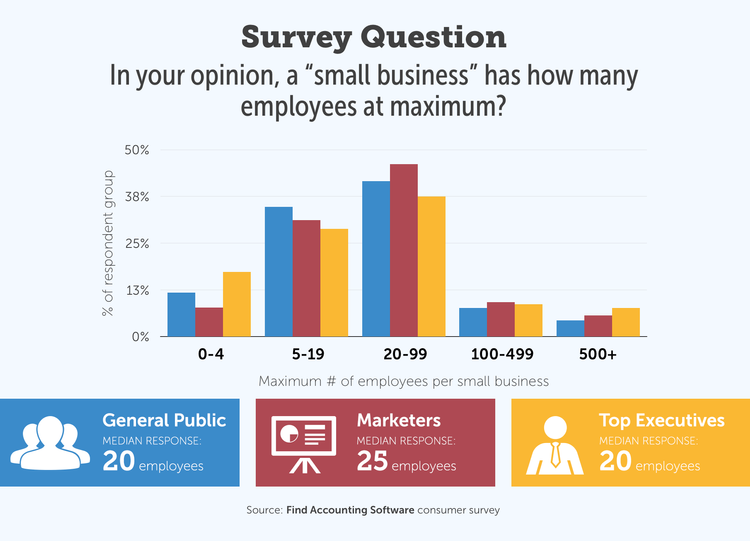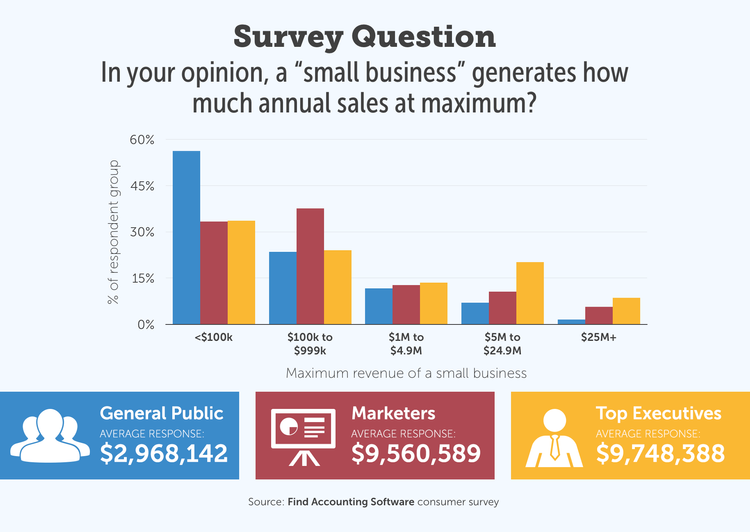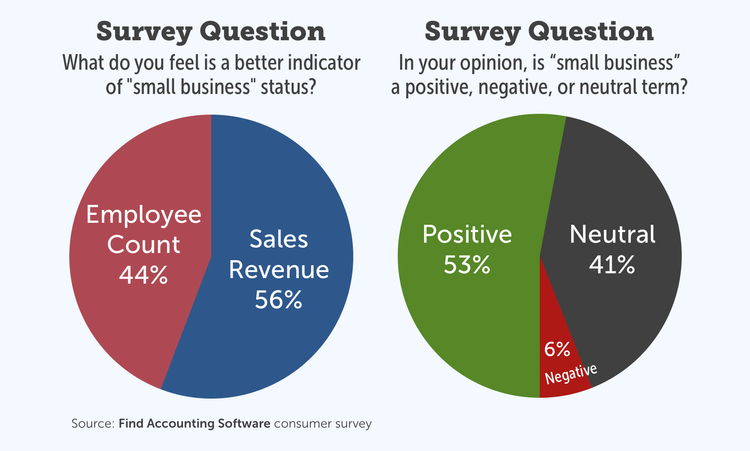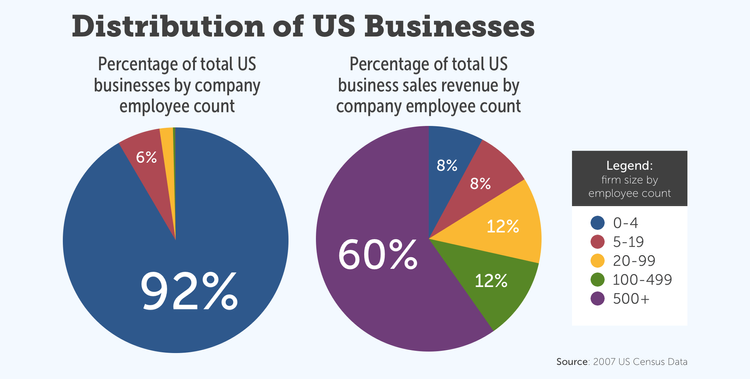Study: What is a “Small Business”?
Key finding: Stop marketing ineffectively; start qualifying the term.
Here’s a question for you: What’s a “small business”?
Think about it for a second. It’s actually a bit tricky to define, isn’t it?
It’s definitely the small-town, one-chair barber shop. But what about the ten person contracting business doing a few million in sales a year?
Or what if ten is the employee tally for an investment firm managing hundreds of millions of dollars? Does that still count? How about a manufacturer who employs a couple hundred workers? Where’s the cut-off?
What’s considered a “small business” isn’t an academic issue. The various formal definitions provided by the government influence everything from loan eligibility to tax burden. And, what we mean when we use the term informally is equally important, as well. After all, simply qualifying the noun “business” with the adjective “small,” is one of the most basic ways that B2B marketers signify their intended audience.
But do we really know what a “small business” is? Is there any agreement on the topic? And, if there isn’t, should marketers rely on the term so heavily in their B2B messaging?
We figured there was only one way to figure out the consensus of what makes for a “small business.” We asked.
We surveyed over 500 respondents and gathered opinions from the general public, marketers, and business executives on the issue. Their “small business” definition answers may surprise you. They definitely surprised us! In fact, only our barber example meets the general public’s preferred definition of “small business,” according to our research.
Let’s look at the numbers.
How Does the Government Define “Small Business?”
The first numbers to consider are the ones the government uses when it defines “small business.” Here’s a quick snapshot of the most significant definitions of “small business” the government has offered:
| - | US Small Business Association (SBA) | HealthCare.gov | Internal Revenue Service (IRS) |
|---|---|---|---|
| Standard: | 500 employees or less–generally. | 50 employees or less. | Dependent on individual tax law statutes. |
| Used for: | Determining eligibility for government loans, consulting, and contract work. | Defining Affordable Care Act compliance and employer health insurance requirements. | Calculating company tax responsibility. |
For a more detailed look at the various government definitions of “small business”–and how they shift depending on circumstance–see our recent article: “How Does the Government Define ‘Small Business’?”
What’s interesting to observe overall is that there is a lack of a single government definition. So the government is a bit conflicted about what a “small business” is. 500 employees, after all, is considerably more than 50. But what do most people think?
How Many Employees Can a “Small Business” Have?
Employee counts are one of the most common ways to quantify “how big” an organization is. Consequently, we were interested to find out how people would define a “small business” in terms of the number of workers. Here’s what we discovered when we asked the question: “In your opinion, a ‘small business’ has how many employees at maximum?”

The answers we received regarding “small business” employee counts illustrate a few interesting points.
To start, it’s clear that people don’t agree on a single, employee count definition of “small business.” The answers we received cover a diverse range.
It is worth noting, though, that while the answers ranged, we didn’t find much change in the response pattern between the three different groups we surveyed: the general public, marketers, and executives. In fact, the response pattern was very consistent between these groups. [For more on the demographics of the three groups we surveyed, see our “Methodology” section.]
While our survey-takers defined “small business” with varying numbers, they did generally agree on one thing: the base Small Business Administration definition of 500 employees is way out of sync with popular opinion. In fact, 90% of the public thought that a “small business” should have under 100 employees. Only 4% of the general public thinks a “small business” can have 500 or more employees.
The Affordable Care Act definition of a “small business” (50 employees or less) fared quite a bit better than the Small Business Administration standard. While 50 employees is higher than the median employee count answers for our three respondent groups, “50” was actually the single most popular answer in two of the three respondent groups (the general public and marketers).
Key Takeaway: Despite the large spectrum of answers, people generally define “small business” as meaning a very limited employee count. The median answers for maximum employee count were 20, 25, and 20 for the general public, marketers and executives, respectively.
How Much Revenue Can a “Small Business” Generate?
Besides employee count, the other most common way people tend to quantify company size is via annual sales revenue. We asked the question: “In your opinion, a ‘small business’ generates how much annual sales volume at maximum?”

From an annual sales revenue perspective, we found survey respondents attracted to narrow definitions of “small business.” We were surprised by just how narrow these annual sales driven definitions were, though.
Nearly 80% of the general public, for instance, set the break point for maximum sales revenue in a “small business” at $1M or under. That percentage shrinks down to 70% when constraining the answer to marketers and 57% for executives.
No matter how we looked at the data, we continued to arrive at this conclusion: The general public as a whole seems a bit of out of touch when it comes to the likely scale of annual sales revenues! We kind of hate to say it–we’re members of the general public too after all–but that seems to be the unavoidable conclusion. Here’s what we mean:
56% of the general public believes a “small business” generates under $100K at maximum. That strikes us as a curiously limited definition. Perhaps that’s okay, though; it’s just an opinion right? But the opinion goes from curious to confusing when considering the general public’s previously identified median maximum “small business” employee count of 20.
If you think through the significance of the numbers, the math looks like this: A business generating $100K in annual sales revenue would only be able to pay employees $5,000 a year if they’re employing 20 employees. And, that’s only if that company has no overhead costs and generates no profit! It simply doesn’t add up.
Quite a few marketers and executives actually offered similarly curious takes on the maximum amount of revenue businesses could generate (33% in each group said under $100K), while still being considered a “small business.”
However, when looking at the full range of answers provided by marketers and executives, the actual average maximum annual revenue answers meshed much better with the payroll realities of employing a couple dozen people. $9M is a sufficient, if not ample, amount of sales revenue to maintain a payroll of that many employees for most business models.
Key takeaway: What’s the upshot of Joe Public’s confusion about realistic “small business” annual sales volumes? We think there’s a critical insight to be observed: Annual sales volume is not a meaningful way to signify “small business” status to most people. We think we know why too. When does the average person look at an income statement and assess annual revenues? For most people, the answer is never. But everyone who goes to work can easily look around and count up co-workers. The tangibility of employee counts strikes us as the most likely reason it makes for a more reliable metric when communicating with people about “small business” status.
What’s a Better Qualifier for “Small Business” Status: Employee Counts or Annual Sales Revenue?
Interestingly, our conclusion regarding the unreliability of using “annual sales revenue” to determine “small business” status conflicts with the thoughts of our survey respondents!
Here’s what we asked: “What do you feel is a better indicator of “small business” status?” The choices were: “employee count” or “annual sales revenue.”

Surprisingly–we found that the general public claimed to prefer defining “small business” as a product of “annual sales revenue” by a margin of 56% to 44%.
So, is there a benefit to defining “small business” by annual sales volume? Perhaps. It does help avoid some tricky aspects related to using employees as the defining metric. For instance, do full-time and part-time employees count the same? How about 1099 vs W-2 workers? What about a volunteer or intern?
In an ideal world, annual sales revenue really might be the more rigorous and consistent way to define “small business” status. But we think the numbers clearly show that the practicality of using annual sales volume as a means to communicate “small business” status is debatable, at best.
Case and point: Remember our example of a ten person contractor doing a “few million” in sales? We’re willing to bet that struck you as a “small business.” But by the preferred indicator of annual sales volume, we found that more people than not would judge that company to be something other than a “small business.” At least, that’s what the general public’s median annual sales volume of $2.9M suggests. Hmm… Call us skeptical, but we’re not ready to endorse that definition. Here’s a bonus observation from our survey results: Asking for opinions and agreeing with them can be two very different things!
How Do Employee Count Definitions of “Small Business” Line Up With Real World Company Size Data?
We wondered what percentage of real-world companies would meet the the employee count driven “small business” standards our survey uncovered. So we took a look at the US Census data to find out.

According to the most recent US Census data, 89% of the 27.7 million US firms have 19 or fewer employees. 19 is an interesting break-point in company size to consider, especially considering that we discovered 20 was actually the general public’s median number for “small business” as a measure of employee counts. So: Based on US Census data and our median “small business” employee count numbers, more people than not would describe 89% of American businesses as “small businesses.”
Interestingly, while the vast majority of businesses fit most people’s employee count driven definition of “small business,” these companies generate a proportionally low percentage of the United States’ overall sales revenues. The latest census data identified total sales receipts of $30.7 trillion for all US businesses. The 89% of American businesses that had 19 or fewer employees actually only generate 12% of overall annual sales revenue.
A Summary of Key Findings
We started with a question: “What’s a ‘small business’?”
Along the way we discovered some definitive answers.
Generally, people consider a “small business” to be much smaller in terms of employee count than the government standards. Once a company has 25 employees, only a minority of any of our respondent groups felt that it could be described as a “small business.”
Also, when it comes to qualifying a “small business” by maximum annual sales revenue, the data revealed a split between marketers and executives and the general public. But, again, on the whole, people gravitated toward a fairly narrow definition of “small business.” When a company’s sales revenues reach into the tens of millions, that’s beyond what the majority of our respondents in each of our surveyed groups would call a “small business.”
Finally, it bears mentioning, the range of answers we received was very, very wide. Yes, we could and did find the break-points between majority and minority definitions of “small business” based on both annual sales revenue and employee count. But the spectrum of answers ranged widely beyond these break-points. We think there’s an important lesson in the enormous variety of answers we received to the larger question of, “What’s a ‘small business’?”
The way we use “small business” matters. “Small business” is not some esoteric, uncommon term. It comes up again and again in everyday language. Marketers rely on it to describe their intended audience for products and services. Heck, we hear it all the time when we talk to companies who describe the need for “small business accounting software.” And, let’s face it, the media and politicians wouldn’t know what to do without the term!
But while the term “small business” is pervasive, it is anything but precise. If you think you are being specific when you use the term, you might want to give it a second thought. All considered, people take it to mean a large variety of things.
There’s no reason to give up on the term “small business,” though. As our final survey question revealed, only 6% of respondents felt it was a negative term. Marketers, politicians, and the media can safely continue with their embrace of “small business.” They’ll just want to make sure to further qualify what they truly mean by “small business” to best connect with their intended audience.
Methodology
The data presented in this report originates from two sources: Google Consumer Survey questions answered between 1/28/2014 and 2/4/2014 and 2007 US Census Data.
Further methodology details:
The survey-takers described as “marketers” answered “yes” to the question: “Are you employed as a professional marketer?” The survey takers described as “executives,” selected either “Business Owner” or “Top Executive” as their response to the question: “What best defines your employment status?”
For “general public” respondents: 31.6% of the general public were female, 39.2% were male, and 29.2% did not disclose gender.
The age distribution for the “general public” respondents was as follows:
- 18-24: 9.4%
- 25-34: 12.7%
- 35-44: 10.0%
- 45-54: 14.7%
- 55-64: 14.7%
- 65+: 8.0%
- Unknown: 30.4%
The following represent the sample sizes for each survey question:
“In your opinion, a ‘small business’ generates how much annual sales volume at maximum?”
- General public: 503 responses
- Marketers: 141 responses
- Executives: 104 responses
“In your opinion, a ‘small business’ has how many employees at maximum?”
- General public: 510 responses
- Marketers: 141 responses
- Executives: 104 responses
“What do you feel is a better indicator of ‘small business’ status?”
- General public: 500 responses
“Do you generally consider the term ‘small business’ to be positive or negative?”
- General public: 500 responses
The collected survey responses have not been “weighted” in any fashion.
What Do You Think?
We uncovered some interesting data about what people consider to be a “small business.” But the discussion is far from over. We expect that people’s opinions will continue to evolve. What do you think? Let us know what you consider a “small business.” Tweet @SoftwareConnect with the hash-tag #defineSB.
